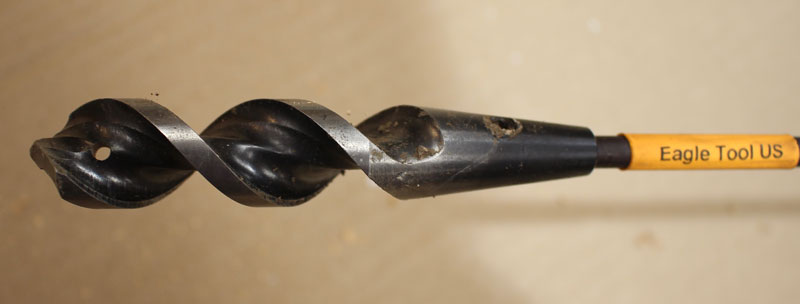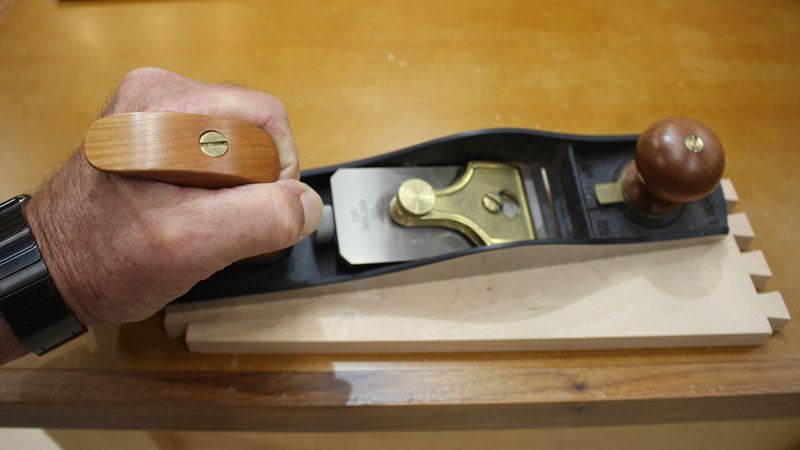|
|
|
|
The Down to Earth Woodworker
By Steven D. Johnson
Racine, Wisconsin
|
|
Previous Page
1
2
3
The Right Tools Do Make A Difference
Click on any picture to see a larger version.
My shop is pretty much perfect for me. That is not intended to sound "uppity" but rather that I am "content." There is not an overwhelming need for any new tools or equipment. Oh, I might want to upgrade a thing or two, but these are not overarching, consuming, or even necessary "needs" --- just casual "wants." I can build virtually anything I want in my shop, and the basic tool complement is well covered.
But when I get outside my shop (and admittedly outside my comfort zone), the tools at my disposal are mostly "woodshop tools," and are sometimes just not quite what are needed to do the job. Case in point: I recently purchased a tractor with a backhoe and front end loader. My paltry complement of metric and imperial sockets and wrenches are fine for adjusting woodworking equipment, but for the tractor I need big, honking 7/8", 1", and bigger wrenches. I have never needed, or owned, a torque wrench, but guess what? I need one now… maybe two. And a grease gun. And a pair of channel-locking pliers the size of my forearm. And a flat screwdriver bigger than a quarter-inch, and… well, you get the idea.
I try to get by with what I have, but while a 10" long adjustable wrench is super handy for tightening nuts on a planer, it is pretty much worthless for changing out the bucket on a backhoe.
One of the many outdoor projects on this summer's "to do" list was installing low voltage lighting around and throughout the front flower beds and landscaping. To do it correctly, I needed to run a wire under a 36" wide concrete sidewalk. The internet is awash with recommendations for "easy" ways to fish a wire under a concrete walk. The first technique I tried involved digging a ditch 36" long running perpendicular to the sidewalk, then sawing a pointy end into a piece of 3/4" PVC and using a mini-sledgehammer to drive it through under the concrete. After about three hours of hot, miserable, frustrating work, my PVC pipe had made it in about 10 inches and would go no further.

|
Figure 4 - The dirt auger bit cuts through compacted soil like a hot knife
through butter. Note the little hole in the end that allows you to attach a
wire and pull it back through the hole
|
Another bolus of videos recommended high pressure water to "drill" a hole under concrete. After another couple of hours of hot, miserable, frustrating, and now wet muddy work, I was no further along. I just had a bigger mess. I packed it in for the day, took a long hot shower, grabbed a glass of wine, and went back to the internet. There were dozens of different ideas, some very expensive, some ridiculously expensive, and some that were just plain rabbit holes down which I disappeared into a labyrinth of links. Finally, almost by accident, I found a "dirt auger" drill bit, but alas, it wasn't long enough. A little more searching, though, and I found a dirt auger that is 52" long, has a semi-flexible shaft, fits in a 3/8" drill chuck, and as a bonus, the end of the bit has a small hole where once through, you can tie on your wire and pull it back through the hole. It only cost about $20. I ordered it, "rush please", and got it in two days.
Getting out my old variable speed plug-in electric drill and stringing out extension cord took almost 10 minutes. Drilling all the way through, under the sidewalk, took about 10 seconds. Amazing what having the right tool can do!
It is equally amazing what havoc can be wrought by using the wrong tool. If you tell me you have never, ever, even once in your life, used a screwdriver as a chisel… or worse, used a chisel as a screwdriver… I am going to look at you with a wry grin of disbelief. Have you wiggled a drill bit a little bit to make a hole just a little bit bigger? Of course you have! Out of desperation I once tried to use a small Phillips head screwdriver as a nail set! A small slotted screwdriver might fit in that square drive head, and might even turn it a bit, but neither the tool or the screw will ever be the same. As hard as it is to admit this, sometimes it isn't even a matter of not having the right tool, it is the sheer laziness of not wanting to go find it. I was repairing a gutter the other day and used a pair of tin snips to cut a small branch from a tree that was in my way. So sad! Well, I was up on a ladder and climbing down would have taken a lot of time, and that tree sap on my tin snips will eventually wear off.
All these "right tool" and "wrong tool" thoughts began to percolate when I watched a buddy sanding the sides of a drawer that was just a bit too tight. We talked, he sanded, I drank coffee, he sanded, and pretty close to an hour later we had solved most of the world's problems and he finally had a drawer that fit okay. On the drive home I thought, "Geez buddy, get a plane!" A couple of quick swipes and that drawer would have fit perfectly. And he would have saved an hour! For crying out loud, get a plane!
There are a lot of reasons some woodworkers don't have or use
handplanes
. Number one among those is
sharpening
. It seems that for many people sharpening is some mysterious elusive and intimidating "art." Also high on the list of excuses for not owning a plane is that many woodworkers have had bad experiences trying to use a cheap, poorly made plane. An inferior plane cannot be sharpened and set-up well, so it is a double-whammy. And rounding out the reasons for disdaining planing is that a good plane costs some serious dinero. It doesn't matter. Save your pocket change, have a garage sale, borrow from Momma, but GET A PLANE!

|
Figure 5 - The
Lie-Nielsen No. 62 Low Angle Jack
is just about perfect
as a first... or only... plane. Its low angle blade configuration is forgiving,
easy to use, and easy to adjust
|
And don't just get any plane, get a good plane. For me, the single most versatile plane in my shop is a "jack," but you may prefer a block plane. Either way, stop what you are doing, right now, and order a high-quality plane. A good choice for a "first plane" is the
Low Angle #62 Jack Plane
made by Lie-Nielsen. A low angle plane is easy to set up and easy to use, it is versatile, easy to sharpen, and its medium length makes it, more often than not, "the right tool for the job."
On the Highland web site there is an
excellent article by Lee Laird
that provides some additional information about the #62 jack plane. Click on the link to read it, or just take my recommendation and order it now by
clicking here
. You might never waste another hour sanding!
(Page 2 of 3)
Previous Page
1
2
3
Next Page

Steven Johnson is retired from an almost 30-year career selling medical equipment and supplies, and now enjoys improving his shop, his skills, and his designs on a full time basis (although he says home improvement projects and furniture building have been hobbies for most of his adult life). Steven can be reached directly via email at
sjohnson@downtoearthwoodworking.com
Return to the
Wood News Online
front page
|
|
|
|
|